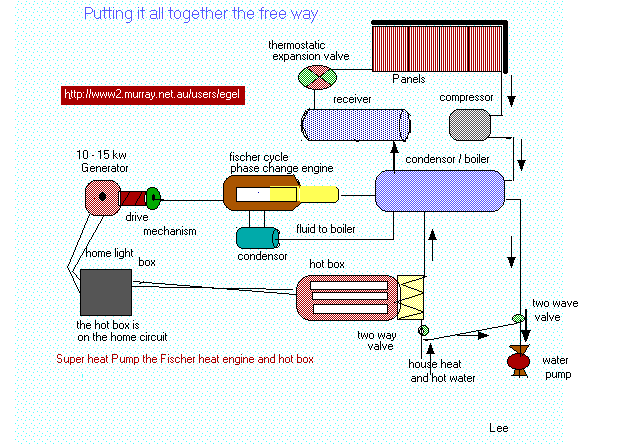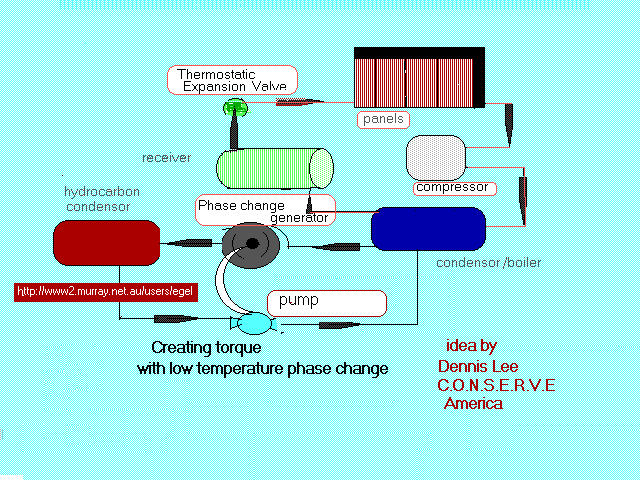
Two of MFC's principals are franchise holders of a recently developed Low Temperature Phase Change Technology ("LTPC").
This "LTPC" functions as refrigeration in reverse. It collects thermal energy much like a refrigerator except, rather than evacuating ambient heat from within a "box" and dissipating it by means of a coil outside the box, the innovative application of the principle takes ambient air from outside the box, compresses it, creating high-volume heat under pressure within its container.
Hot gas runs turbine => Electricity
Water cools hot gas => Hot Water
System requires water for cooling; high volume of hot water produced. Hot water uses in greenhouse heating, homes, driveways etc...

Free Energy from Air, a Layman's explanation.
Lets see how this technology meets the criteria for practicality. What we are calling practical is a unit that takes energy from the air 24 hours per day or night, 365 days and nights a year. It should produce up to 50,000 kWh of free electricity per year at the retail cost of about $12,000 including a hot box thermal storage system for backup power. In addition it produces free electricity harmlessly with no pollution, toxic waste or damage to the environment.
The first law of thermo-dynamics is important for explaining how a heat pump works. The law says that a hotter substance will give its heat to a cooler substance until the two equalize in temperature. A heat pump uses a very cold liquid like Freon and exposes it to the ambient environment in flat plate collectors. These liquids (refrigerants) boil at -40 degrees F. Anything in the environment that comes in contact with this liquid through the flat plate collectors is going to give up its heat to that liquid. Is there anything in the environment that you can think of that is colder than -40 degrees F? Sun? Rain? Wind? It may get pretty cold, but even the snow has heat to give up to the refrigerant. If snow is 32 degrees F and the refrigerant boils at -40 degrees F, we have a 72 degree thermal gradient that can be removed from the snow. There is a limitless supply of molecules outdoors that are warm enough to continually boil the refrigerant. By exposing refrigerant to the air through evaporative plates we can cause the refrigerant to boil any time.
When a substance phase changes, or changes its state from liquid to gas, it absorbs a tremendous amount of energy. For example, if we heat water from 55 to 212 degrees F and bring it to a boil, we consume six times as much energy to get it one more degree over the boiling point than it took us to bring it up 157 degrees F from 55 to 212.
Changing liquids to gases absorbs a tremendous amount of energy. While the refrigerant is absorbing a tremendous amount of energy to go from liquid to gas, the temperature remains low, because the gas is in a vacuum, expanding through a huge flat plate collector without any pressure. Compressing that energy into a smaller space would increase the pressure, raise the temperature, and change its boiling point.
We can transfer the heat and use it to provide energy for us. The gas running freely through the evaporators is directed into a compressor, where a piston in the compressor draws like a syringe and fills up with energized gas. Then all the gas is squeezed into a very small area and thereby increasing the temperature of the gas. The gas comes into the piston chamber at 50 degrees F and comes out after being compressed at 250 degrees F. The compressor does not put the heat into the gas, it merely squeezes it out, like squeezing a sopping wet sponge. The 250 degrees F gas is now hot enough to use to heat water or air and actually transfer the heat produced.

To make electricity using a turbine, your electric supplier uses water which boils at 212 degrees F and heats it up to 1,000 degrees F or more in a pressurized boiler. The pressure is released as the steam escapes past a turbine blade. If we were to take our 250 degrees F hot gas coming out of our compressor we could use it to boil another low temperature substance which would become gas and turn blades that rotate a shaft, just like the electric company.
But instead of heating up water that boils at 212 degrees F in a pressurized vessel, we use hot gas to excite a substance that typically boils at -40 degrees F. This builds up a lot pressure that makes our gas escape through turbine blades [or air motor], and rotate a shaft powering a generator to produce electricity.The difference between what we and the electric company are doing to produce electricity is that we are working at much lower temperatures with energy from the air, whereas they are burning coal or oil to heat water to 1000 degrees F. Their process of burning things to obtain high temperatures pollutes the environment whilst this process we call Low Temperature Phase Change burns nothing and provides safe, clean, cost free energy.
Our flat plate evaporator measures 8 by 3 feet. Two thin sheets of aluminum are silk screened with a vein pattern and heated and pressed together under 200 tons of pressure to bond together as one piece except in the places where the dye of the silk screen made the vein pattern. The veins actually poke out as the oxygen from the metal is pressed out of the aluminum. The result is a 8' by 3' flat collector with a network of veins to put a refrigerant into and let boil through to the other side.